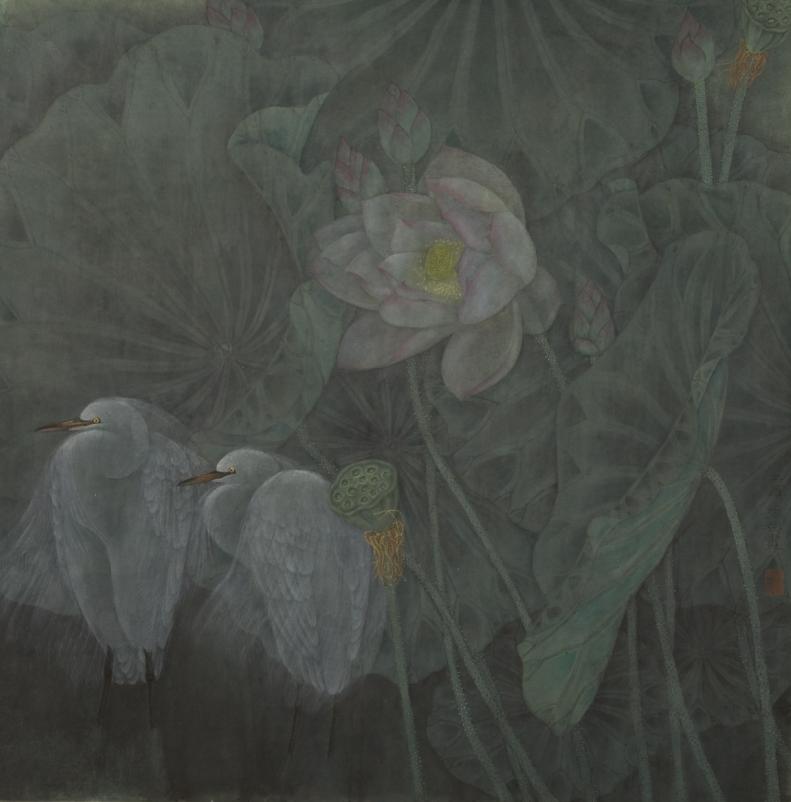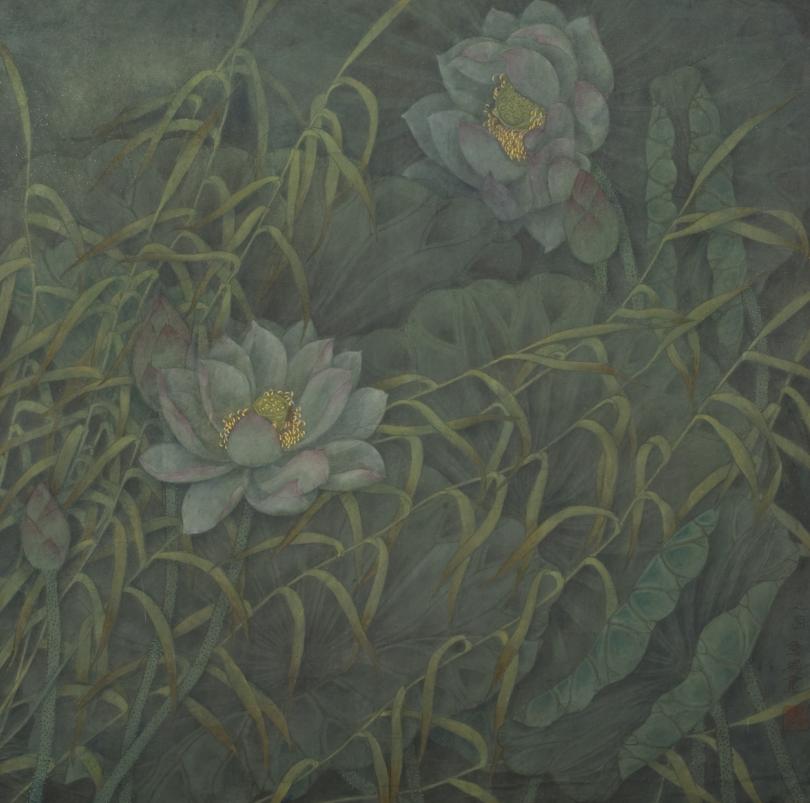A Journey From Soul to Soul — How I Paint Lotuses
By Zhao Xiuhuan
In traditional Chinese culture, the lotus is regarded as a flower of unique beauty. Under the graceful and delicate exteriors of lotuses, lies a dignified and proud soul — growing in the mud yet remaining untainted. For hundreds of years, Chinese poets have chanted eulogies to this special flower with numerous verses. Poets are not the only lotus lovers, artists also hold dear this special flower. It is no exaggeration that almost all Chinese artists have created artworks on lotuses. However, I, an avid lotus lover, did not start to work on lotuses until after I had already painted floral scenery for 10 years. It was because of my inability to properly communicate my feelings for them with my brush that I refrained from painting these beautiful flowers.
China is never short of lotus masterpieces. “Lotus out of Water”, a painting by an unknown artist of the Song Dynasty (926—1279) became a timeless gongbi classic for its delicacy and decorativeness. Renowned modern Chinese art masters, including Yu Feiyin, Qi Baishi and Pan Tianshou, also contributed amazing lotus artworks with their own distinguished personal style. Additionally, the lotus had been the dominant subject of flower and bird paintings in exhibitions of traditional Chinese arts for many years. In spite of all of this, rather than feel inspired, I felt lost in front of a sea of lotus paintings. I kept asking myself how I should depict this enchanting flower in my own style. I knew I was the only one who could find the answer to this question.
Later, I realized that the only way to look into the soul of a lotus is to communicate with them face to face. However, there were no suitable places to do this in Beijing. The lotuses in Beihai Park were in the middle of the lake and too far for me to gain a closer look. Those in Purple Bamboo Park (also known as Zi Zhu Yuan) were behind high fences, blocking my view of them. I did not find the perfect place to start this soul-to-soul journey until 1990. That place was a lotus garden in California with over 200 new varieties that a botanist cultivated in over a decade, including some precious varieties which displayed three colors at different times in the day. I was very excited to find so many fantastic subjects for my sketches. Around mid June every year, I would go to the garden and do sketches next to the water from 7 o’clock in the morning to midday. I stared at the lotuses, using my pen to delineate the curves of the corolla, the overlapping of the petals and the interlacing of the leaves, buds and seedpods. I couldn’t help but marvel at nature, which had the magic to create such elegant and artless flowers with unparalleled attraction.
Little by little, I approached lotuses, from their exteriors into their souls, by painting sketches of them. During the process, my passion for lotuses built up until one day it was so strong that I could not hold it in anymore. I had to speak out! It was then that effusive lotus artworks just flew out from the tip of my brush. Now the lotus has become the most frequent subject of my floral landscapes.
According my own experiences, there are four steps to creating a stunning lotus painting.
Step 1: Observe the lotuses.
Take a few deep breaths and calm down. Spread out the paper and hold a gel pen with an extra fine point in your hand. Look at the flowers, starting from the ones that are closest to you, and then go further out until you find the most beautiful scene to work on. Isolate the key elements (one or a cluster of flowers) in a scene and check their placement.
Step 2: Communicate with the lotuses.
Have a soul-to-soul “talk” with the flowers, like making friends or paying respects to a teacher. It is through this that you can feel that you are getting closer to their soul.
Step 3: Become one with the flowers.
It is not enough to just know the flowers. You need to know them so well that you see and grasp each and every subtle detail. Upon the completion of the first three steps, you are ready to begin the formal painting.
Step 4: Think thrice and create the artwork.
There are three tips.
Tip 1: Decide on the colors before you start. For example, I use a red dragonfly to decorate layers of lotus leaves in “Mint Haze”. Although the use of contrast color is an old trick, it is the perfect artistic expression to highlight that particular artwork. Also, a touch of red brings warmth and liveliness to blocks of cooling and tranquil green. This is the secret to making this painting one that withstands close examination.
Tip 2: Plan the composition carefully to create the perfect arrangement for each element. “Breeze” is an ink-based painting with a shade of purple and consists of many elements. The reed, which is tinted gold, leans to the left. The lotuses in full bloom sway towards the reed. The surrounding buds and seedpods set off well on the flower on the focal point and make it more lithe and graceful.
Tip 3: Improvise as you paint. I have done a quadruplet of lotuses, consisting of “Transparent”, “Lonely”, “Rain and Breeze” and “The Last Bloom”. These four artworks portray different characteristics of the lotus with varied composition, tone and emotions.
In “Transparent”, the key element is a corolla, large but not obtrusive, since the petals appear sheer after being washed many times. Therefore, the corolla looks as if it’s hidden behind the lotus leaves.
“Lonely” depicts a pair of lotuses encompassed by lotus leaves, buds, seedpods and reeds. One is in full bloom, while the other starts to wither. The contrast of the two flowers emphasizes the lonely and desolate atmosphere.
In “Rain and Breeze”, certain petals are falling off in the rain and raindrops roll down from leaves of reed. Lotus leaves cover the buds and fallen petals like large umbrellas. The lotus stems are swaying from side to side in the breeze. If the rain is able to wash the lotuses clean, then such poetic floral scenery is certainly capable of purifying one’s heart.
In “the Last Bloom”, a lotus is at the end of bloom and half of its petals have disappeared. A plump seedpod faces the petals in the water as if it says to the petals “Don’t be sad, I have also been a flower in blossom”. Next to the remaining half of the corolla, a bud is about to bloom. This beauty offers proof that the circle of life will never end much like the never-ending miracles nature presents us with.
Practice makes perfect. It is important for the painter undergo this four-stop journey, transferring the soul of the painter to that of the flower. It is when the lotus is allowed into one’s heart, that they are able to remain close to one’s soul.







